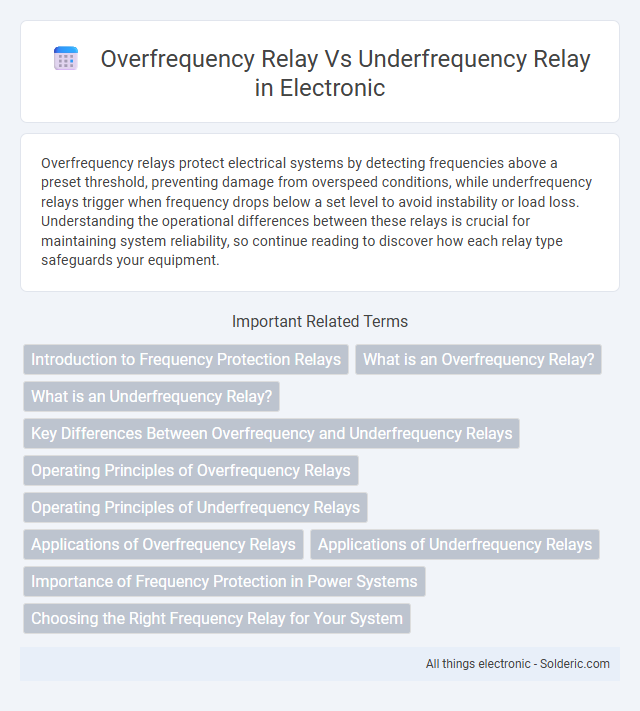Overfrequency relays protect electrical systems by detecting frequencies above a preset threshold, preventing damage from overspeed conditions, while underfrequency relays trigger when frequency drops below a set level to avoid instability or load loss. Understanding the operational differences between these relays is crucial for maintaining system reliability, so continue reading to discover how each relay type safeguards your equipment.
Comparison Table
| Aspect | Overfrequency Relay | Underfrequency Relay |
|---|---|---|
| Function | Detects frequency above set threshold | Detects frequency below set threshold |
| Purpose | Protects system from over-speed or high frequency damage | Protects system from low frequency instability or failure |
| Typical Setpoint | Frequency above nominal (e.g., > 60 Hz) | Frequency below nominal (e.g., < 60 Hz) |
| Applications | Generators, turbines, and power grids | Generators, motors, and load shedding schemes |
| Action | Trips or disconnects load to reduce frequency | Trips or disconnects load to stabilize frequency |
| Response Time | Fast to prevent equipment damage from overspeed | Fast to prevent system collapse from underfrequency |
Introduction to Frequency Protection Relays
Frequency protection relays monitor power system frequency deviations to prevent equipment damage and maintain grid stability. Overfrequency relays activate when system frequency exceeds a preset threshold, protecting against overspeed conditions in generators and turbines. Underfrequency relays detect when frequency drops below a set limit, preventing voltage collapse and system blackouts by initiating load shedding or disconnection protocols.
What is an Overfrequency Relay?
An overfrequency relay is a protective device used in power systems to detect and respond to frequency levels that exceed a predetermined threshold, preventing damage to generators and equipment. It monitors the system frequency continuously and triggers corrective actions or alarms when the frequency surpasses set limits, ensuring grid stability. Overfrequency relays are essential for maintaining operational safety during load changes or disturbances in electrical networks.
What is an Underfrequency Relay?
An underfrequency relay detects and responds to a drop below a predetermined frequency threshold in an electrical power system, protecting equipment from damage caused by insufficient frequency levels. Commonly used in power grids, this relay helps maintain system stability by initiating load shedding or generator disconnection when frequency falls dangerously low. You rely on underfrequency relays to safeguard your electrical network from frequency-related disturbances and potential blackouts.
Key Differences Between Overfrequency and Underfrequency Relays
Overfrequency relays activate when the electrical system frequency exceeds a predefined upper limit, protecting equipment from damage caused by excessive speed or load conditions. Underfrequency relays, conversely, trigger when the frequency drops below a set threshold, indicating potential issues like generator failure or heavy load demand. Understanding these key differences helps you select the appropriate relay to maintain system stability and prevent power outages.
Operating Principles of Overfrequency Relays
Overfrequency relays operate by continuously monitoring the system frequency and activating when it exceeds a predetermined threshold, ensuring protection against frequency surges that can damage equipment. These relays utilize electromechanical or digital sensing methods to detect overfrequency conditions quickly and isolate affected parts of the power system. Understanding the operating principles of overfrequency relays helps you maintain system stability and protect critical infrastructure from frequency-related faults.
Operating Principles of Underfrequency Relays
Underfrequency relays operate by monitoring the electrical system's frequency and activating when it drops below a predetermined threshold, indicating an imbalance between load and generation. These relays utilize frequency-sensitive components such as electromechanical disks or digital signal processors to detect deviations from nominal frequency values, typically set around 50 Hz or 60 Hz depending on the grid standard. The relay's trip signal helps protect generators and prevent grid instability by disconnecting loads or triggering corrective actions when underfrequency conditions threaten system reliability.
Applications of Overfrequency Relays
Overfrequency relays are critical in power systems to protect generators and motors from damage caused by excessive frequency, which can occur during sudden load drops or generator overspeed conditions. These relays are commonly employed in hydroelectric, thermal, and renewable energy plants to ensure operational stability by disconnecting or tripping equipment when frequency exceeds preset thresholds. Their role is vital in preventing equipment failure, grid instability, and maintaining synchronized power supply across interconnected networks.
Applications of Underfrequency Relays
Underfrequency relays are primarily used to protect electrical systems by detecting drops below preset frequency thresholds, preventing equipment damage and maintaining system stability during power system disturbances. Their applications include load shedding in power grids to avoid system collapse, safeguarding generators from operating under low-frequency conditions, and controlling motor-driven equipment sensitive to frequency variations. Your power system relies on underfrequency relays to swiftly isolate faults and maintain reliability during frequency deviations.
Importance of Frequency Protection in Power Systems
Frequency protection in power systems is critical to maintaining grid stability and preventing equipment damage caused by frequency deviations. Overfrequency relays detect and respond to abnormally high frequencies that can result from generation imbalances, while underfrequency relays protect against low frequency conditions often caused by sudden load increases or generation loss. Your power system relies on these relays to ensure continuous reliable operation by quickly isolating faults and minimizing the risk of cascading failures.
Choosing the Right Frequency Relay for Your System
Selecting the appropriate frequency relay depends on the system's tolerance to voltage and load variations, where overfrequency relays protect against excessive speed by tripping circuits when frequency rises above a preset threshold, ensuring generator and motor safety. Underfrequency relays activate when frequency drops below a specific level, preventing equipment damage due to low-speed operation or power quality issues. Understanding the operational frequency range and system sensitivity is essential to optimize protection and maintain stability in power networks.
Overfrequency relay vs underfrequency relay Infographic

 solderic.com
solderic.com